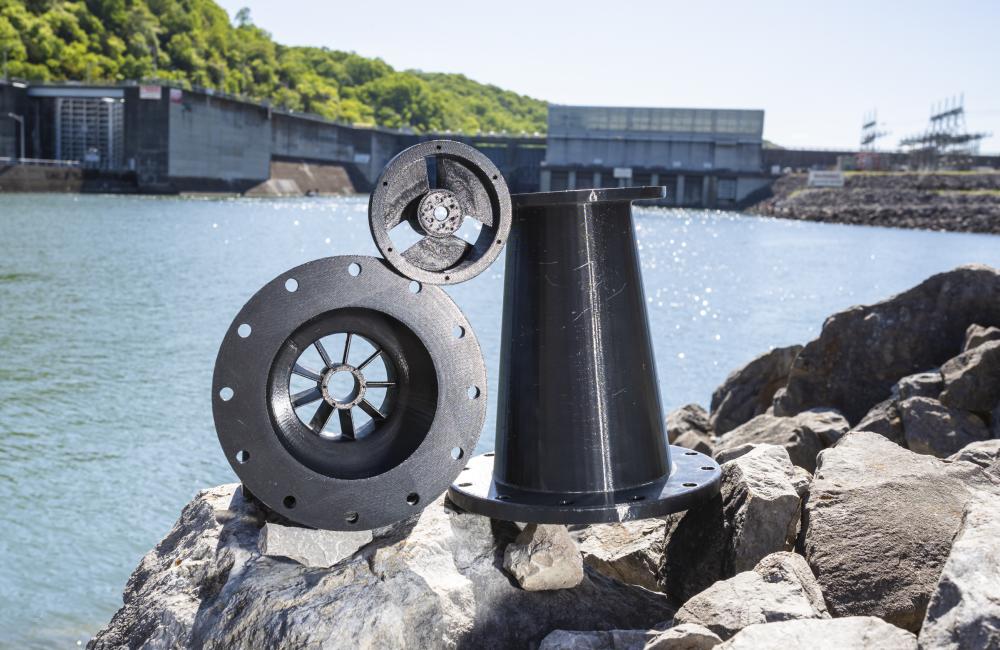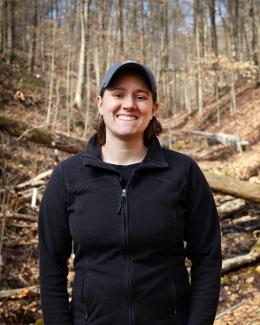Researchers at Oak Ridge National Laboratory contributed nine projects to the most recent annual Accomplishments Report issued by the U.S. Department of Energy’s Water Power Technologies Office (WPTO), one of which was the Advanced Manufacturing for Hydropower project, which produced the components pictured here at Melton Hill Dam in May 2023. Credit: Carlos Jones/ORNL, U.S. Dept. of Energy
Projects spearheaded by researchers at Oak Ridge National Laboratory (ORNL)’s Water Power Program made up about one-fourth of those featured in the U.S. Department of Energy’s Water Power Technologies Office (WPTO) new 2022-2023 Accomplishments Report.
The year-end report, which was released March 15, highlights a selection of about 40 of the many projects advancing hydropower and marine energy technologies that are sponsored by WPTO. The projects are intended to optimize the development of water power, which will play a key role in reaching the nation’s goal of creating a clean electricity grid by 2035 and a net-zero-emissions economy by 2050.
Nine of ORNL’s Water Power Program projects were featured as major accomplishments in the report.
- WPTO spotlighted the Advanced Manufacturing for Hydropower project, an initiative that grew out of a 2022 workshop with scientists, policy makers and industry leaders that was hosted by Oak Ridge National Laboratory. The meeting generated a report, issued in March 2023, which examined the challenges faced by the industry and highlighted how new, advanced materials and manufacturing techniques could lower operation costs and increase the efficiency of the country’s existing hydropower fleet and future facilities.
- The agency also lauded another, earlier effort spearheaded by the same group of researchers, the Test Facility for Hydropower and Pumped Storage Technology project. In October 2022, the group released a report identifying key improvements in investment needed to improve hydropower testing capabilities in the United States, along with resources that could aid in carrying out these improvements.
- For the Small Hydropower Grid Interconnection Study project, a team of researchers from ORNL and Pacific Northwest National Laboratory (PNNL) compiled data on costs and timelines for small hydropower interconnection projects, which are defined as those that generate less than 20 megawatts of power. The purpose of the report was to create a one-stop shop for facility owners and operators as they look to connect new and existing facilities to the electricity grid.
- The Pumped Storage Hydropower Liner Study was led by Argonne National Laboratory, supported by ORNL, and Stantec Inc. This initiative resulted in a report examining the viability and effectiveness of different materials to line reservoirs at pumped storage hydropower (PSH) facilities, where frequent, rapid changes in water levels can put an added burden of stress on reservoir lining systems. The ultimate aim of the report it to help improve decision-making on linings used at PSH facilities.
- Researchers at Oak Ridge took the lead on another important report, the Third Assessment of the Effects of Climate Change on Federal Hydropower, which was a collaboration between ORNL, PNNL, Texas A&M University, Power Marketing Administrations and other federal hydropower stakeholders. With the aid of state-of-the-art hydroclimate projections, the report details how climate change may affect water availability for federal hydropower marketing and generation, as well its impact on future energy demand.
- WPTO highlighted Environmental DNA (eDNA) Applications in Hydropower Fish Passageways, a project that uses novel technology to pioneer a new, noninvasive approach for detecting fish near hydropower facilities. It was tested at five facilities in Michigan with the support of the state’s department of natural resources. Rather than tracking the fish themselves, the technique involves collecting water samples and analyzing genetic material excreted by the animals. Findings show that the technique is far less harmful to the fish than traditional tracking, cheaper and more precise, estimating the number of fish moving through a hydropower facility’s fish passages with 98% accuracy.
- Another project showcased by WPTO is Quantifying Greenhouse Gas Emissions from Hydropower Reservoirs, which is measuring emissions of greenhouse gases like carbon dioxide and methane from six hydropower reservoirs in the southeastern United States. The research has introduced a new level of nuance into the discussion by showing that many of the bodies of water act as both carbon sources and absorbers, depending on the season.
- WPTO and ORNL researchers collaborated to release a comprehensive overview of the current state of the U.S. hydropower industry, the 2023 edition of the Hydropower Market Report. The report, which is the fourth to be produced since 2015, analyzes the latest data from public and commercial sources, details new research findings and development projects, and summarizes this information by region, plant size, owner type and other characteristics.
- A final project of note is a massive public-private partnership led by researchers at ORNL that also involves PNNL, Sandia National Laboratories, the National Renewable Energy Laboratory, Solvay, Dow Chemical, Biosynthetic Technologies, and Driven Racing Oil. The project, Novel Eco-Friendly High-Lubricity Ionic Liquids for Marine Turbomachinery Lubrication, is developing new additives compatible with environmentally acceptable lubricants, which can then be used in tidal energy turbines. The goal is to improve device performance while decreasing the environmental risk posed by leaks or spills. The project is funded through WPTO’s Seedling and Sapling program, which is designed to support innovative concepts and new ideas at the U.S. Department of Energy's national laboratories.—Clare Kennedy









